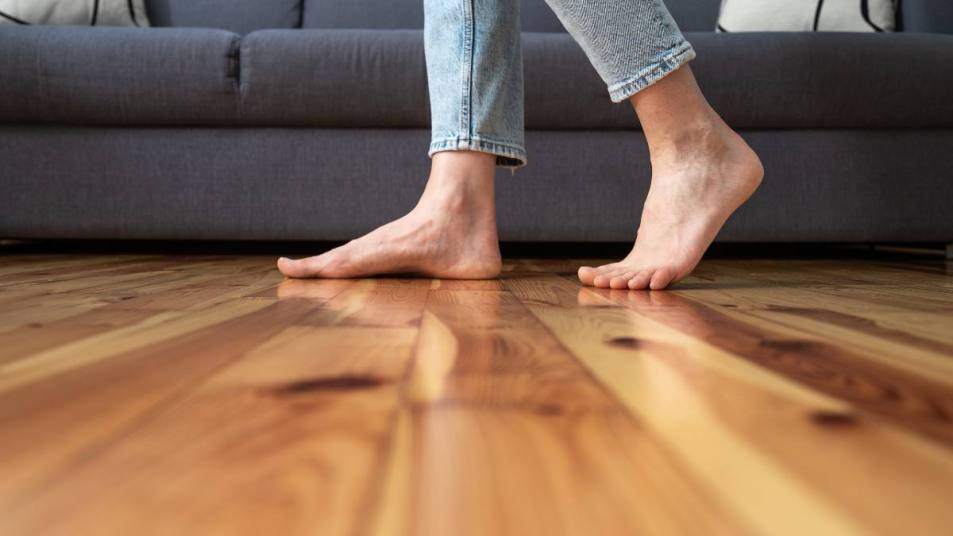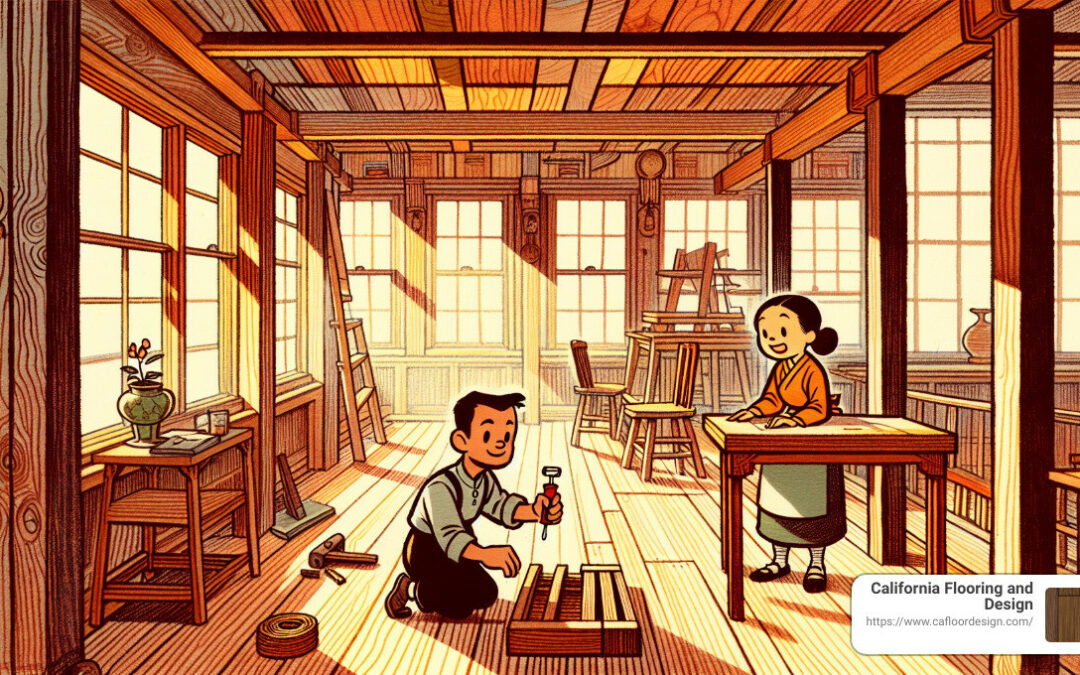To make wood floors less creaky, try tightening loose floorboards and adding lubricant to friction points. Creaky wood floors can be a nuisance in any home, disrupting the peaceful ambiance and potentially causing discomfort.
Fortunately, there are several simple and effective solutions to address this common issue. By following a few straightforward steps, you can eliminate or significantly reduce the creaking noises, restoring tranquility and comfort to your living space. This article will explore various methods to make wood floors less creaky, providing you with practical tips for a quieter and more enjoyable home environment.
Whether you are dealing with minor creaks or more pronounced noises, these solutions can help you address the problem efficiently and effectively.

Credit: www.firstforwomen.com
Identifying The Source Of Creaks
To make wood floors less creaky, start by identifying the source of the creaks. Inspect the subfloor, joists, and fasteners to look for any loose or damaged components. Addressing these issues can help reduce the creaking and make your wood floors more enjoyable to walk on.
Checking For Loose Floorboards
Understanding The Causes Of Creaks
In identifying the source of creaks, start by checking for loose floorboards. Loose floorboards are a common cause of wood floors being creaky.
To check for loose floorboards, walk around the room and apply pressure to different areas, listening for any creaking sounds. Inspect visually for any gaps or movements in the floorboards.
Once loose floorboards are identified, it’s crucial to understand the causes of creaks to address them effectively.
Common causes of creaks include changes in humidity, improper installation, and aging of the wood. By addressing these issues, you can make wood floors less creaky.

Credit: www.everhartconstruction.com
Basic Troubleshooting Techniques
Using Talcum Powder
Add talcum powder in between the creaky floorboards.
It helps to reduce friction and minimize the creaking sound.
Inserting Wooden Shims
Slide wooden shims into gaps beneath the floor.
Ensure they are snug to provide support and reduce creaking.
Advanced Solutions For Persistent Creaks
When it comes to persistent creaks in wood floors, advanced solutions are needed to tackle the problem effectively. These solutions go beyond the basic remedies and provide long-lasting relief from those annoying noises that disrupt the peaceful ambiance of your home. Here, we will explore advanced techniques to make wood floors less creaky, focusing on applying wood lubricants and installing reinforcement braces.
Applying Wood Lubricants
Wood lubricants can be an effective solution for persistent creaks in wood floors. By applying a lubricant specially designed for wooden surfaces, you can reduce friction between the floorboards and minimize the occurrence of creaking noises. Ensure to choose a high-quality wood lubricant that penetrates the wood and provides long-lasting relief from creaks. Prior to application, thoroughly clean the floor to remove any dirt, dust, or debris that could hinder the effectiveness of the lubricant. Apply the wood lubricant along the seams of the floorboards, focusing on the areas where creaking is most pronounced. Allow the lubricant to penetrate the wood and dry completely before allowing foot traffic on the treated areas.
Installing Reinforcement Braces
If creaks persist despite other attempts to remedy the issue, installing reinforcement braces can provide structural support to the wood floors and minimize creaking. These braces, often made of metal or specialized wood materials, are strategically placed beneath the floorboards to reduce movement and friction. Ensure to carefully measure and align the placement of the reinforcement braces to provide optimal support and stability. If unfamiliar with the installation process, consider consulting a professional to ensure proper positioning and secure attachment. Additionally, regularly inspect and maintain the reinforcement braces to prevent any potential issues that could lead to renewed creaking.
Professional Assistance And Maintenance
Reduce wood floor creakiness with professional maintenance services. Expert assistance can identify and fix the underlying issues to make your floors silent and smooth. Regular maintenance will enhance durability and keep your wood floors in top condition.
Creaky wood floors can be frustrating and disrupt the peace in your home. While there are many DIY solutions you can try to reduce the noise, seeking professional assistance and regular maintenance can provide a long-lasting and effective solution. By enlisting the help of experts, you can ensure that the underlying causes of the creakiness are addressed, leading to a quieter and more enjoyable living space.
Seeking Help From A Professional
If you find that your wood floors are persistently creaking despite your best efforts, it may be time to call in a professional. A seasoned flooring specialist will be able to evaluate the condition of your floors and determine the root cause of the creakiness. Whether it’s due to loose floorboards, inadequate subflooring, or humidity-related issues, a professional will have the expertise to identify the problem and provide suitable solutions.
Remember to choose a qualified and experienced flooring professional for the job. Look for online reviews and recommendations to ensure you are hiring someone reliable and trustworthy.
Regular Inspection And Care
Prevention is always better than cure, and the same applies to creaky wood floors. Regular inspection and care can help prevent the problem from worsening over time. Get into the habit of checking for any signs of damage, loose boards, or gaps in the flooring. Addressing these issues promptly can prevent further damage and minimize the chances of increased creakiness.
In addition to inspection, proper care is crucial. Keep the floors clean and free from dirt and debris that can exacerbate the creaking sounds. Avoid using excessive amounts of water when mopping, as this can seep into the wood and cause swelling or warping. Instead, use a damp mop or a specialized wood floor cleaner to gently remove any dirt or stains.
Regular care also includes maintaining the appropriate humidity levels in your home. Extreme fluctuations in humidity can cause the wood to expand and contract, leading to creakiness. Use a humidifier during the dry months and a dehumidifier during the humid months to maintain a consistent humidity level.
Taking these preventive measures and implementing regular inspection and care routines can contribute to a significant reduction in wood floor creakiness over time. However, it is essential to note that each flooring type and situation may require specific care instructions, so be sure to consult with a professional or refer to the manufacturer’s guidelines for the best results.
Preventive Measures For Future Creaking
To prevent future creaking in wood floors, ensure proper installation and use felt pads under furniture legs. Keeping humidity levels stable and fixing loose floorboards promptly can also help make wood floors less noisy. Regularly sweeping and cleaning can prevent debris buildup, reducing friction and minimizing creaking sounds.
Maintaining Optimal Humidity Levels
One of the key factors in preventing future creaking in wood floors is maintaining optimal humidity levels in your home. Changes in humidity can cause the wood to expand and contract, leading to creaking sounds. To prevent this, it’s essential to keep the humidity levels within the recommended range.
- Avoid excessive moisture in your home by using a dehumidifier in damp areas like basements or bathrooms.
- During the winter months when the air tends to be drier, use a humidifier to add moisture to the air.
- Keep the humidity level between 40% and 60% to ensure the wood floors stay stable.
Utilizing Area Rugs
An effective way to reduce creaking in wood floors is by utilizing area rugs strategically throughout your home. Area rugs provide additional cushioning and support to the wood, reducing the friction that causes creaking sounds. Here are some tips for using area rugs to prevent future creaking:
- Place area rugs in high-traffic areas such as hallways, entryways, and living rooms.
- Ensure the rug size is appropriate for the room, covering a significant portion of the floor to distribute the weight evenly.
- Use rug pads beneath the area rugs to provide extra cushioning and grip, preventing slippage and further reducing the creaking.
- Regularly clean and vacuum the area rugs to remove any dirt or debris that could scratch or damage the wood floors.

Credit: www.cafloordesign.com
Frequently Asked Questions For How To Make Wood Floors Less Creaky
How Do I Stop My Hardwood Floors From Creaking?
To stop hardwood floors from creaking, try using powdered graphite, baby powder, or silicone lubricant in the floor joints. Apply the powder or lubricant into the creaking joints and work it in with a soft brush or cloth to reduce noise.
Regular maintenance can also prevent future creaking.
Why Do My Hardwood Floors Squeak When I Walk On Them?
Hardwood floors squeak when walked on due to loose floorboards or friction between the subfloor and hardwood. This occurs because of age, moisture changes, or improper installation. Regular maintenance and addressing the underlying issue can help eliminate the squeaking.
How Do You Make Wood Floors Less Noisy?
To make wood floors less noisy, try using area rugs or carpets to absorb sound. You can also use felt pads under furniture legs to reduce noise. Additionally, filling in gaps or loose boards with wood filler or adhesive can help minimize creaks.
How Do I Stop My Floor Boards From Creaking?
To stop floor boards from creaking, try tightening loose boards, applying lubricant between boards, or inserting shims. Regular maintenance and ensuring even weight distribution can prevent creaking. If the problem persists, seek professional assistance.
Conclusion
Addressing creaky wood floors can greatly enhance the comfort and tranquility of your living space. By implementing the tips and tricks mentioned in this blog post, you can significantly reduce the annoying noises and enjoy a quieter home environment. Follow these suggestions and reclaim the peace and quiet of your wood floors.

